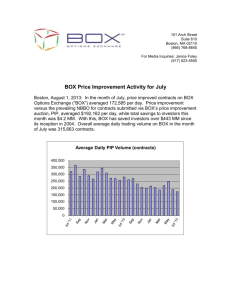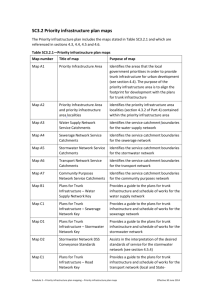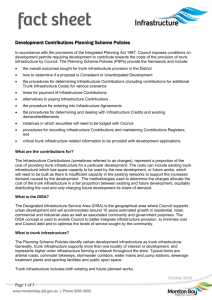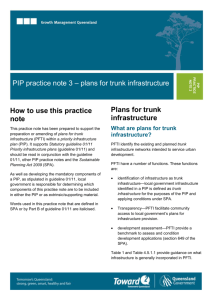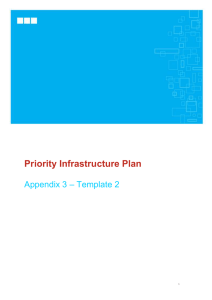priority infrastructure plans template
advertisement
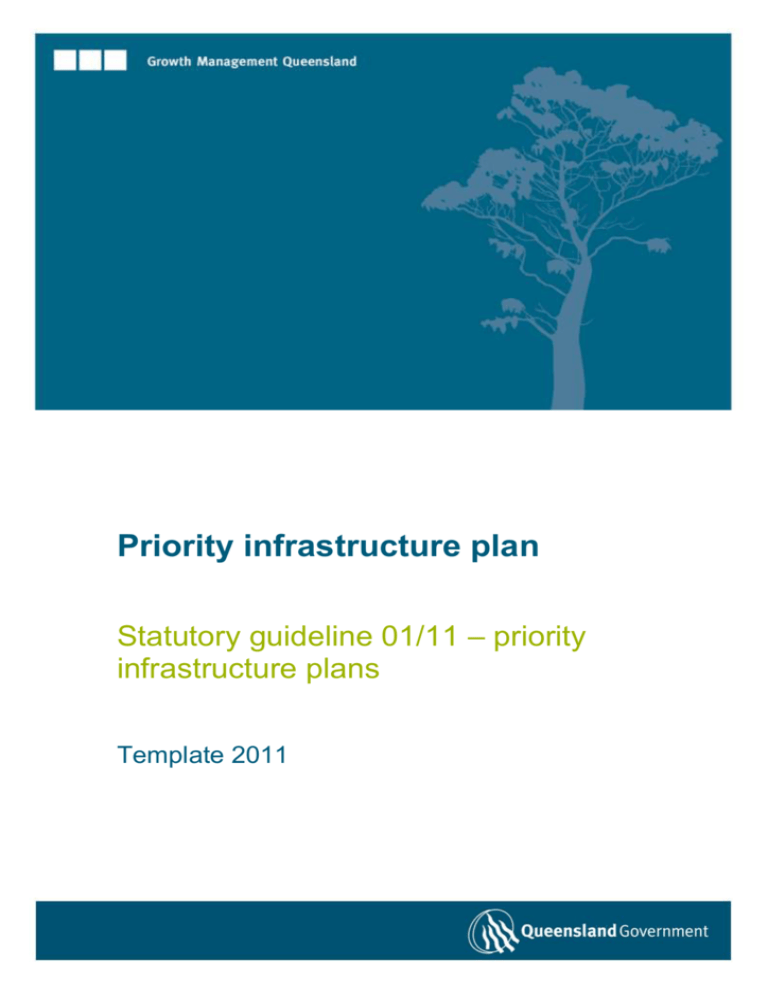
Priority infrastructure plan Statutory guideline 01/11 – priority infrastructure plans Template 2011 Priority infrastructure plan - ii - About this template <All text shaded in grey is subject to further local government review and amendments to reflect local government circumstances. Sections of text and parts of tables that are not relevant should be deleted. All text in brackets offers general drafting guidance and is to be deleted.> < In regards to formatting and numbering the template provided below is Queensland Planning Provision version 3 compliant. PIPs must be consistent with the relevant local government planning scheme. > <Refer to relevant practice notes for more information on the preparation of the PIP.> Priority infrastructure plan - iii - Part 4 Priority infrastructure plan 4.1 Preliminary (1) This priority infrastructure plan has been prepared in accordance with the requirements of the Sustainable Planning Act 2009. (2) The purpose of the priority infrastructure plan is to: (3) (a) integrate and coordinate land use planning and infrastructure planning (b) ensure that trunk infrastructure is planned and provided in an efficient and orderly manner. The priority infrastructure plan: (a) states in Section 4.2 (planning assumptions) the projections of future urban growth and the assumptions of demand for each trunk infrastructure network, which have informed the preparation of the priority infrastructure plan (b) identifies in Section 4.3 (priority infrastructure area) the prioritised area to accommodate urban growth for 10 to 15 years (c) states in Section 4.4 (desired standards of service) for each network of development infrastructure the desired standard of performance of infrastructure (d) identifies in Section 4.5 (plans for trunk infrastructure) the existing and planned trunk infrastructure for the following networks: (i) water supply (ii) wastewater (iii) stormwater (iv) transport (v) public parks and land for community facilities. 4.2 Planning assumptions (1) The planning assumptions form a logical and consistent basis for the planning of the trunk infrastructure networks and the determination of the priority infrastructure area. < Voluminous background planning assumptions documentation may be included in a relevant planning scheme schedule.> <Low and no growth local governments with small population town centres may base assumptions about demand generation on the population, dwelling, employment and floorspace growth projection tables. In these cases, projections must be included in the PIP and not in a schedule.> Priority infrastructure plan -4- <Medium and larger local governments will develop more detailed demand generation assumptions. Where demand generation assumptions are included in the PIP, local government can choose to include other background planning assumptions material in either the PIP or a planning scheme schedule> 4.3 Priority infrastructure area (1) The priority infrastructure area is the area where suitable and adequate development infrastructure exists, or where it can be provided most efficiently. (2) The priority infrastructure area identifies the area where <insert council name> council gives priority to provide trunk infrastructure for urban development up to 20XX. (3) The priority infrastructure area is identified in <insert reference to relevant map>. <Local government may choose to include a summary map of the PIA here. More detailed PIA maps can be included in a relevant planning scheme schedule> 4.4 Desired standards of service (1) The desired standard of service details the standards that comprise an infrastructure network most suitable for the local context. (2) The desired standard of service is supported by the more detailed network design standards included in planning scheme policies, legislation, statutory guidelines and other relevant controlled documents about design standards identified below. Water supply <insert local government specific outcomes for the desired standard of service> Wastewater <insert local government specific outcomes for the desired standard of service> Stormwater <insert local government specific outcomes for the desired standard of service> Transport <insert local government specific outcomes for the desired standard of service> Public parks and land for community facilities <insert local government specific outcomes for the desired standard of service> Priority infrastructure plan -5- 4.5 Plans for trunk infrastructure (1) The plans for trunk infrastructure identify the existing and proposed trunk infrastructure networks intended to service the assumed development at the desired standard of service stated in the PIP. (2) The plans for trunk infrastructure are identified in <insert reference to relevant component of PIP such as maps and tables>. Editor’s note - Extrinsic material The documents identified in the following table assist in the interpretation of the PIP, and are extrinsic material under the Statutory Instruments Act 1992. Title of document Date Author or organisation who prepared document Other relevant information Definitions <The following terms are to be included in the glossary or definitions section of the planning scheme. Those local governments that have developed their PIP and planning schemes using the Queensland Planning Provisions version 3 (QPP v3) can disregard this section as these definitions are already included in the QPP template.> Term Definition Base date The date from which a local government has estimated its projected infrastructure demands and costs. Demand unit Demand units provide a standard unit of measurement to express demand on a trunk infrastructure network. Net developable area The area of land available for development. It does not include land that cannot be developed due to constraints such as acid sulphate soils, conservation land, flood affected land or steep slope. Note – For the purpose of a PIP net developable area is usually measured in hectares, net developable hectares (net dev ha). Netserv Plan A distributor-retailer’s plan about its water and wastewater networks and provision of water service and wastewater service pursuant to section 99BJ of the South East Queensland (Distributor Retailer Restructure) Water Act 2009. Priority infrastructure plan -6- Term Definition Planning assumptions Assumptions about the type, scale, location and timing of future growth. Planning assumptions Area or areas within a local government area for which a local government carries out demand growth projections. Service catchment A service catchment is an area serviced by an infrastructure network. An infrastructure network is made up of one or more service catchments. Service catchments are determined by the network type and how it has been designed to operate and provide service to the urban areas. For example: stormwater network service catchments can be delineated to align with watershed boundaries open space network service catchment can be determined using local government accessibility standards water network service catchments can be established as the area serviced by a particular reservoir. Ultimate development The realistic extent of development anticipated to be achieved when a site (or projection area or infrastructure service catchment) is fully developed. Urban purposes Urban purposes includes residential (other than rural residential), retail, commercial, industrial, community and government related purposes. Abbreviations [The following terms are to be included in the abbreviations section of the planning scheme.] DDS PFTI PIP PIA Priority infrastructure plan desired standard of service plans for trunk infrastructure priority infrastructure plan priority infrastructure area -7-


